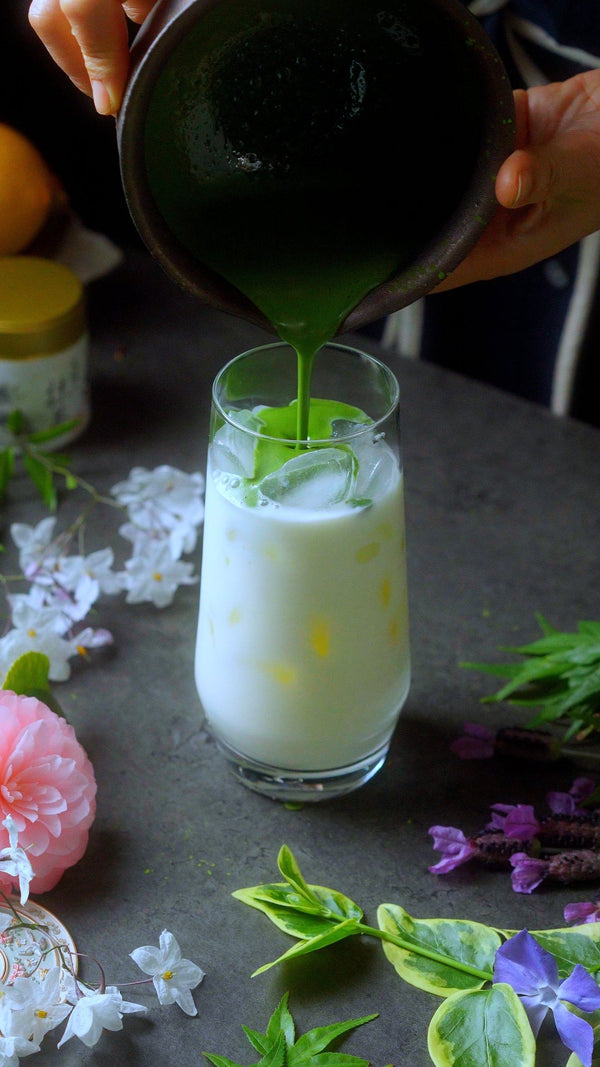
How to Choose the Best Matcha Powder for Lattes
Share
Quick Summary
Not all ceremonial matcha works for lattes.
“Seaweed” or savory umami notes can clash with milk.
Latte-grade matcha needs fine grinding and balanced sweetness.
Matcha particle size affects mouthfeel and foam.
Test matcha both as usucha and with milk before buying.
1. A Sleepy Morning and a Bitter Lesson
I first realized not every high-grade matcha works for a latte on a sleepy morning in Napa.
I whisked my usual Kyoto matcha—fresh, bright, and elegant. Then I thought, what if I try it with milk today?
The result was… confusing. The sweetness was gone, the aroma turned flat, and a faint “fishy” edge appeared.
That moment changed how I tasted matcha forever. Since then, every time farmers send me samples, I divide them into two groups: one for usucha (thin tea), and one for latte testing.
Only those that shine in both make it to my future lineup.

2. Why “Better” Doesn’t Always Mean “Better for Lattes”
People often assume that the higher the grade, the better the latte. But matcha behaves differently once milk enters the equation.
Milk introduces fat and protein, which bind with polyphenols and amino acids in matcha. That can mute delicate floral notes and amplify bitter or marine flavors.
What tastes elegant in a chawan may taste off in a cup with milk.
3. The Taste Profile of Matcha (and What to Avoid)
The Taste Profile of Matcha (and What to Avoid)
| Category | Flavor Notes | Pairs Well with Milk? | Comment |
|---|---|---|---|
| Fresh Grass / Sweet Bean | Smooth, mellow, slightly sweet | ✅ Yes | Creates creamy balance |
| Seaweed / Umami (Nori-like) | Savory, oceanic | 🚫 No | May turn “fishy” with milk |
| Roasted / Nutty | Deep, comforting | ✅ Yes | Enhances latte warmth |
| Bitter / Astringent | Sharp, dry | ⚠️ Partial | Can be softened with extra milk |
| Floral / Vanilla | Gentle, elegant | ✅ Excellent | Works well with oat or almond milk |

Community testers on Reddit and tea forums also warn about this:
“Don’t use your usucha-only matcha for lattes—it tastes like seaweed soup.”
Why it sometimes turns “oceanic”
Milk contains fat and casein, which bind with polyphenols and amino acids in matcha.
That changes how umami reads on the palate — from savory to oddly marine.
Matcha with strong nori-like notes is rich in free amino acids and certain volatiles. Beautiful in usucha, less ideal with milk fat.
Coarse or unevenly ground powder dissolves poorly, leaving pockets of bitterness.
Overheating (above ~70 °C) can alter aromatic compounds, boosting bitterness and grassy sharpness.
How to avoid off-notes
Test twice — one cup as usucha, one as a latte, with small doses.
Smell first — if the aroma feels oceanic or savory, skip milk.
Reduce the dose — 1.5 g per 180–220 ml milk is usually enough.
Switch the milk — oat or macadamia milk softens umami beautifully.
Mind the heat — keep milk around 58–62 °C to preserve sweetness.
Pre-dilute — whisk with 25–30 ml hot water before adding milk.
Check fineness — finer matcha blends smoother and foams better.
Round the edges — a touch of sugar or honey can balance bitterness.

4. Why Shizuoka Matcha Works Beautifully in Lattes
Over time, I’ve found that Shizuoka matcha blends more gracefully with milk than most Uji or Kyoto styles.
The reason isn’t luck. It’s the landscape.
Shizuoka’s tea fields sit under long morning fog, near the ocean yet shielded by mountains.
The soil is rich but not too heavy in nitrogen, so the tea develops a mild umami and soft sweetness, rather than an intense marine flavor.
Even when whisked into whole milk or oat milk, it keeps its brightness — the kind of sweetness that feels alive, not sugary.
That balance also comes from how Shizuoka producers roast (hi-ire) their tencha.
The gentle finishing roast rounds out sharp grassy notes and stabilizes aroma, preventing that “seaweed milk” edge you sometimes get with deeper-shaded Kyoto teas.
When I test matcha samples, Shizuoka blends often perform best in both categories — pure usucha and latte.
They stay calm in water and stay kind in milk.
5.A Personal Rule: Two Cups, Two Worlds
When I test new matcha, I always make two cups—one pure, one with milk.
If both feel alive and balanced, I know it’s something special.
It’s not about chasing the most expensive tin; it’s about how the tea behaves when it meets warmth, air, and time.
Maybe that’s the quiet secret of choosing matcha for lattes:
listen to the moment when flavor meets comfort.
Summary
Choosing the best matcha powder for lattes isn’t about chasing the highest grade—it’s about harmony.
Avoid seaweed-heavy teas, pick fine-ground powders with mild sweetness, and test every matcha in two worlds: pure and with milk.
That’s how you find the cup that wakes you gently, not loudly.

Aileen Gong is a food creator, sommelier, and graduate of the School of the Art Institute of Chicago.
She shares quiet, beautiful recipes that celebrate simple rituals and mindful flavors.
She grows blueberries in pots, hand-whisks her matcha, and believes every drink can be a small moment of peace.
Why does my matcha latte taste fishy?
Likely due to strong seaweed umami compounds (glutamates) reacting with milk fats.
Does matcha color affect taste?
Not always. Bright green usually signals freshness, but dull olive tones can still taste creamy in milk.
What milk type works best?
Whole milk for creaminess; oat or macadamia milk for nutty sweetness.
What is the best matcha powder for lattes?
The best matcha powder for lattes is one that tastes smooth, slightly sweet, and blends easily with milk.
What flavor notes work best for matcha lattes?
Choose matcha with a sweet-bean, floral, or lightly nutty aroma.
These notes stay clear and creamy when mixed with dairy or oat milk.
Avoid blends dominated by nori or seaweed umami; they shine in usucha but can clash with milk fats.
What should I look for when buying matcha for lattes?
Look for ceremonial-grade matcha with tasting notes like “sweet,” “mild,” or “balanced.”
Check for fine texture — it should feel like talc between your fingers.
Prefer stone-milled and shade-grown teas; they give richer color and smoother foam.
Origin matters: Shizuoka and Uji both offer excellent ceremonial matcha, but Shizuoka is often gentler for milk pairing.


